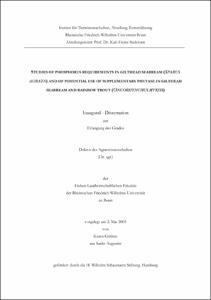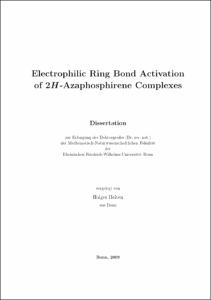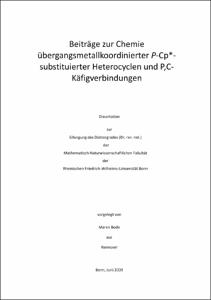Studies of phosphorus requirements in gilthead seabream (Sparus aurata) and of potential use of supplementary phytase in gilthead seabream and rainbow trout (Oncorhynchus mykiss)

Studies of phosphorus requirements in gilthead seabream (Sparus aurata) and of potential use of supplementary phytase in gilthead seabream and rainbow trout (Oncorhynchus mykiss)

| dc.contributor.advisor | Pfeffer, Ernst | |
| dc.contributor.author | Güthler, Karen | |
| dc.date.accessioned | 2020-04-07T16:58:05Z | |
| dc.date.available | 2020-04-07T16:58:05Z | |
| dc.date.issued | 2005 | |
| dc.identifier.uri | https://hdl.handle.net/20.500.11811/2203 | |
| dc.description.abstract | The aim of this study was to test plant feedstuffs as an alternative to fishmeal in diets for rainbow trout and gilthead seabream, focussed on the reduction of phosphorus excretion and the potential use of microbial phytase. The trout experiments took place in Germany in the Institute of Animal Nutrition of the University of Bonn. The seabream experiments were carried out in the National Center for Mariculture in Eilat, Israel. In all experiments digestibility and/or utilisation of phosphorus was determined by the difference method. In two growth experiments response of seabream to rising levels of dietary phosphorus was examined. Each trial contained seven diets basing on wheat gluten. Different levels of dietary phosphorus at constant remaining composition were achieved by supplementation of di-calcium phosphate (DiCaP) in the first and mono-calcium phosphate (MoCaP) in the second experiment. In separated experiments the digestibilities of DiCaP and MoCaP were determined in seabream. In a third growth experiment the effect of rising supplementations of microbial phytase was examined. This experiment was carried out in parallel in trout and seabream using the same diets which based on soy protein concentrate. Weight gain, feed intake, feed conversion efficiency and body composition showed a clear dependence on phosphorus or phytase level at phosphorus deficiency. Exceeding respective dietary phosphorus or phytase concentrations showed no further effects. Phosphorus require-ment of seabream was determined to about 6.5 g digestible phosphorus per kg diet at 18 MJ DE/kg. A supplementation of microbial phytase of 1000 FTU/kg was sufficient to enable maximum weight gain in trout. In seabream the requirement of supplemental phytase could not definitely determined, since overall dietary phosphorus concentration was too low for the demand of gilthead seabream. Additionally several plant feedstuffs were tested for their phosphorus digestibility with and with-out supplementary phytase: full-fat soybeans, soy protein concentrate and rapeseed oilmeal in trout and rapeseed oilmeal in seabream. The trout diets based on wheat gluten. Test components were added achieving a dietary phosphorus level below the requirement of trout. In the seabream experiment rapeseed oilmeal was the only phosphorus source. Phosphorus digestibility of rapeseed oilmeal, soy protein concentrate and soybeans in trout could be increased by supplementation of phytase from 27 to 83 %, from 41 to 93 %, and from 43 to 94 % respectively. In seabream phosphorus digestibility of rapeseed oilmeal was improved from 50 to 84 %. | en |
| dc.description.abstract | Untersuchungen zum Phosphorbedarf von Goldbrassen (Sparus aurata) und zu Einsatzmöglichkeiten von Phytasezusätzen für Goldbrassen und Regenbogenforellen (Oncorhynchus mykiss) Ziel dieser Arbeit war die Bewertung von pflanzlichen Futtermitteln als Alternative zu Fischmehl in der Ernährung von Goldbrassen und Regenbogenforellen, mit Schwerpunkt auf einer Minimierung der Phosphorausscheidungen und dem Einsatz von mikrobieller Phytase. Die Versuche mit Regenbogenforellen wurden in Institut für Tierernährung der Universität Bonn durchgeführt, die Versuche mit Goldbrassen fanden im National Center for Mariculture in Elat, Israel, statt. In allen Experimenten wurde die Verdaulichkeit und/oder Verwertung von Phosphor mit Hilfe der Differenzmethode ermittelt. Der Phosphorbedarf von Goldbrassen wurde in zwei Wachstumsversuchen mit steigenden Phosphorkonzentrationen im Futter bestimmt. Jeder Versuch umfasste sieben Futterischun-gen auf der Basis von Weizenkleber. Als Phosphorquelle wurde im ersten Versuch Dicalcium-phosphat (DiCaP), im zweiten Versuch Monocalciumphosphat (MonoCaP) verwendet. Die Bestimmung der Verdaulichkeiten von DiCaP und MonoCaP erfolgte in einem separaten Experiment. In einem weiteren Versuch wurde der Effekt von steigenden Phytasezusätzen untersucht. Hierbei handelte es sich um einen Doppelversuch mit Regenbogenforellen und Goldbrassen, die dieselben Futtermischungen auf der Basis von Sojaproteinkonzentrat erhielten. Steigende Phosphor- bzw. Phytasekonzentrationen im Futter bewirkten im Bereich der Unterversorgung mit Phosphor eine Erhöhung der Futteraufnahme, des Gewichtsansatzes, der FCE und des Phosphorgehalts im Körper. Bei einer Steigerung der Phosphor-konzentrationen über den Bedarf hinaus konnten keine weiteren Effekte beobachtet werden. Bei Zugrundelegung des maximalen Gewichtsansatzes ergab sich für Goldbrassen ein Phosphorbedarf von 6,5 g verdaulichem Phosphor bei einem Energiegehalt von 18 MJ pro kg Futter. Die notwendige Höhe der Phytasesupplementierung für Forellen lag bei 1000 FTU pro kg Futter. Weiterhin wurden einige pflanzliche Futtermittel mit und ohne Phytasezusatz auf ihre Phosphorverdaulichkeit hin untersucht. Die Futtermischungen für die Regebogenforellen basierten auf Weizenkleber und enthielten Anteile von Sojabohnen, Sojaproteinkonzentrat und Rapsextraktionsschrot. In Goldbrassen kam Rapsextraktionsschrot zum Einsatz, das auch die einzige Phosphorquelle in den Futtermischungen darstellte. Die Phosphorkonzen-trationen im Futter lagen unterhalb des jeweiligen Bedarfs der Fische. Eine Zusatz von 1000 FTU Phytase pro kg Futter bewirkte eine Steigerung der Phosphor-verdaulichkeit von 27 auf 83 % von Rapsextraktionsschrot, von 41 auf 93 % von Sojaprotein-konzentrat, und von 43 auf 94 % von Sojabohnen. Bei den Goldbrassen erhöhte ein Phytasezusatz die Phosphorverdaulichkeit von Raps-extraktionsschrot von 50 auf 84 %. | en |
| dc.language.iso | eng | |
| dc.rights | In Copyright | |
| dc.rights.uri | http://rightsstatements.org/vocab/InC/1.0/ | |
| dc.subject | Goldbrasse | |
| dc.subject | Regenbogenforelle | |
| dc.subject | Phosphor | |
| dc.subject | Phytase | |
| dc.subject | pflanzliche Phosphorquellen | |
| dc.subject | Phosphor-Verdaulichkeit | |
| dc.subject | Phosphor-Verwertung | |
| dc.subject | gilthead seabream | |
| dc.subject | rainbow trout | |
| dc.subject | phosphorus | |
| dc.subject | plant phosphorus sources | |
| dc.subject | phosphorus digestibility | |
| dc.subject | phosphorus utilisation | |
| dc.subject.ddc | 630 Landwirtschaft, Veterinärmedizin | |
| dc.title | Studies of phosphorus requirements in gilthead seabream (Sparus aurata) and of potential use of supplementary phytase in gilthead seabream and rainbow trout (Oncorhynchus mykiss) | |
| dc.type | Dissertation oder Habilitation | |
| dc.publisher.name | Universitäts- und Landesbibliothek Bonn | |
| dc.publisher.location | Bonn | |
| dc.rights.accessRights | openAccess | |
| dc.identifier.urn | https://nbn-resolving.org/urn:nbn:de:hbz:5N-06414 | |
| ulbbn.pubtype | Erstveröffentlichung | |
| ulbbnediss.affiliation.name | Rheinische Friedrich-Wilhelms-Universität Bonn | |
| ulbbnediss.affiliation.location | Bonn | |
| ulbbnediss.thesis.level | Dissertation | |
| ulbbnediss.dissID | 641 | |
| ulbbnediss.date.accepted | 12.08.2005 | |
| ulbbnediss.institute | Landwirtschaftliche Fakultät : Institut für Tiererwissenschaften, Abt. Tierernährung | |
| ulbbnediss.fakultaet | Landwirtschaftliche Fakultät | |
| dc.contributor.coReferee | Sauerwein, Helga |
Dateien zu dieser Ressource
Das Dokument erscheint in:
-
E-Dissertationen (1107)







